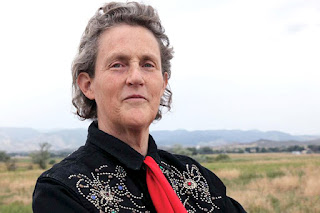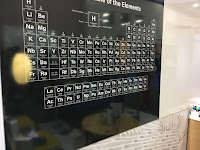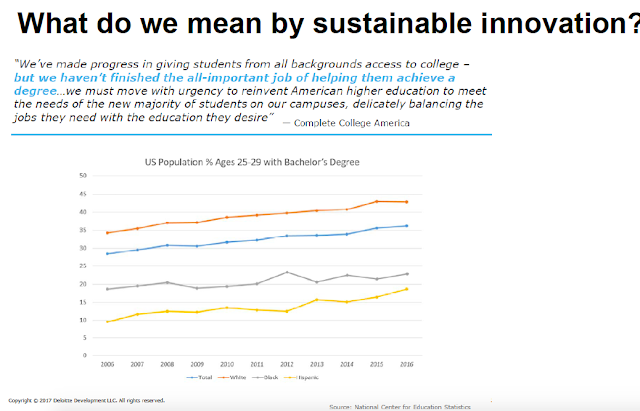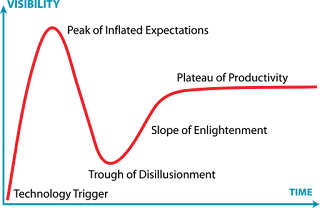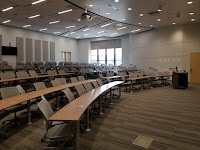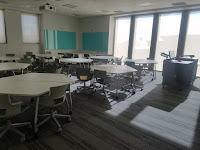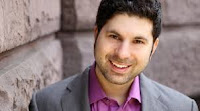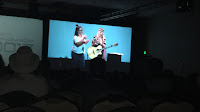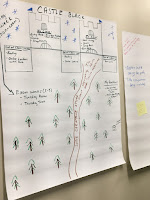The second day of this year's Teaching with Technology was chockful with great ideas and meeting new folks.
 |
| Julie Smith |
Starting us off in the morning, Julie Smith, School of Communication at Webster University, discussed
The Importance of Critical Thinking in this Post-Truth World.
She reminded us how important media literacy is and the necessity for us to teach our students a critical eye on published content because everyone can publish, and everyone makes bad assumptions.
We need to remember that when we want something to be true because we agree with it, we tend to share it with others without a second of thought (Stage 1), so we need to remember to slow down and think in our Stage 2 (
Kahneman's Thinking Fast and Slow), especially when we are sitting in our echo chambers of social media. We have to teach unconscious bias!
Fake news, as she reminded us, has been around forever, but now anyone can create them.
Here are tools she mentioned in her talk:
So, how would you use these tools? For example, if you see an image that looks too good to be true, use Google Reverse Image to see if the same or a very similar image has been published previously. If a news story is breaking and you want to see if it is indeed happening, go to Trends Map and see if anyone else at that location is tweeting about this story - if all the tweets are generated far away, chances are very high this is a hoax. Foto Forensics shows if an image has been photoshopped, and other sites simply cross check that a story is true.
Teaching tip: Break your own News is a web site that allows students to post "news" and watch what happens so that they get personal experience how things can go viral.
The Stanford Civic Online Reasoning research shows that middle school students cannot distinguish an ad from news content -- partly because the ads are so convincing but also because our news publication is so glittery.
She also reminded us that a big part of the problem is that we want to be amused, not educated.
Second session of the day covered Using Geospatial Technologies to Overcome Geographic Illiteracies. Davie Perault, Lynchburg College, discussed 4 types of geospatial technologies: maps, remote sensing, GIS, and GPS.
Students have limited knowledge not just about geographical knowledge, but they simply do not know how to read geographical information, such as maps, so giving them practice on reading maps, reading different kinds of maps and GIS, GPS data, will allow them to function better in the world. Practically any industry today uses this kind of rich data to make decisions, so adding this skill set into different kinds of classes could be very helpful. In addition, GIS data in particular is available for free online for pretty much any major city, making it relatively easy to show the geographic relations for various concepts such as food deserts, flood plains, traffic bottle necks, or historical landmarks.
Third session of the day focused on a
Quest for the Ideal Formative Assessment for First Year Stem. Charley Fleischmann from U of Canterbury, NZ, discussed how he had changed the practices for his first-year engineering students away from the traditional homework discussed in a tutorial to online quizzes that allowed students to practice multiple times, with friends as needed, improving time on task, while the tutorials could be used more effectively by those students who needed the additional help. Online resources guided students through the process without giving them the final answer, and students see more clearly the connections between Physics, Math, and the real world.
Fourth session of the day discussed
How to Enhance Online Communication Using Multiple Levels of Rich Media and Synchronous Technologies. Evie Oregon from West Kentucky U walked us through her 100% online graduate program communication system that is grounded in
Media Richness Theory, giving us ways to decide in what kind of a situation a student needs high level communication contact, and when it is ok to send a low-level email. The bottom line is that we need to be available to our students, and I expect that we need to start doing this more intentionally for our f2f classes as well, which does mean having a better social media strategy. We have to remember that our students are not comfortable coming to office hours -- they are more comfortable texting than talking on the phone! Show you are connected with them, and they will be more willing to reach out, and the richer the media is that you use, the clearer your message is going to be, because a rich video message will not only give the content but also voice and visual cues, while an email stays flat.
The fifth session of the day discussed some
augmented reality (AR) tools to help students immerse themselves more fully into content. Melissa Murfin from Elon U pointed out that especially in courses with a very intense cognitive load in majors that tend to work in cohorts for the entire day, having other ways to bring the content to life is very helpful.
Examples of AR:
https://www.houzz.com/ allows you to "try out" a piece of furniture in your home before you purchase it, using your phone's camera to overlay the furniture image onto the view of your room. In education,
https://alivestudiosco.com/ creates reading and math exercises for K-5.
http://www.arloon.com/en/ has math and anatomy content and other STEM content.
https://daqri.com/ works on professional training AR.
Aurasma allows you to create your own overlay for AR, but it needs to become more user friendly to become useful.
 |
| José Bowen |
The
final keynote was presented by
José Bowen of Teaching Naked fame. He reminded us with carefully selected personal stories and learning examples that
1. Our students start in a very different place from where we are. They use tools like
Healthvana to check out a potential date whom they may have seen getting a high rating on
Lulu (ok, that does no longer rate), because that person's presence popped up on
tinder, and based on this completely indirect "interaction" decide to meet someone. Students do not want to interact in person, certainly not be the first to talk to you.
2. Students do not hang out with friends in a physical space, they have less sex, they date less, they don't want to drive, they are more prone to feel lonely, and they do not get enough sleep because they are constantly checking their devices, going to bed with both their phones and laptops.
2. We grew up learning through books, we love reading books - our students don't - they will find ways and content online that will get them out of reading because it looks like it is the same content.
3. Our students need the following to learn: S.W.E.E.T: Sleep, Water, Exercise, Eating, Time -- they do not need us to learn, though we can give them a lot of help.
So, let's acknowledge these situational factors and work with them: Let's reach out to our students through social media, and let's google our content so that we know what pops up and we can build assignments around this content to stimulate critical thinking. Some possible options that may pop up are
Crashcourse, content on
String Theory or
Charlesmagne. How can we use this in our teaching? Can we create that kind of content? Can we have our
students create this kind of content?
We need to remember that learning happens when we are pleasantly frustrated, we need to focus on digital literacy and work on our new thre Rs: Relationships, Resilience, Reflection
We can guide students to better online content, but they will not take our advice.
Finally, we need to model thinking to our students -- so not just give the answer but make our thinking processes more transparent, admit that we need time to do research and think things through, and state that our minds can be changed.
